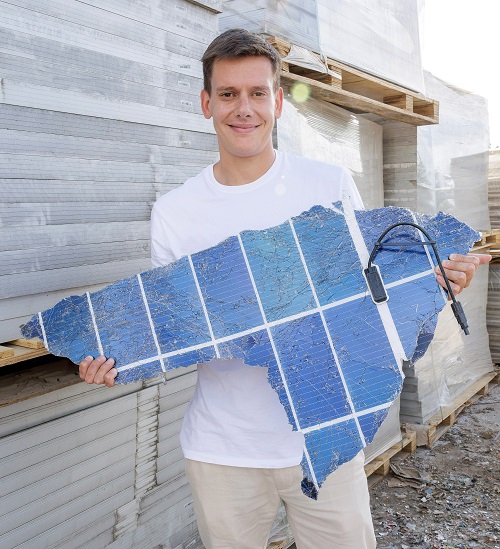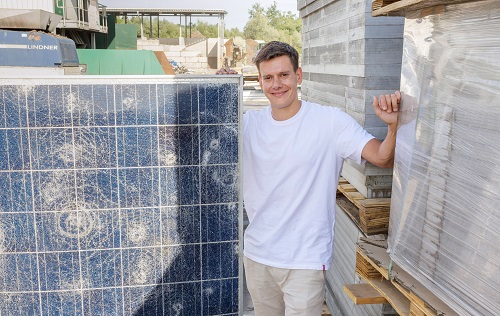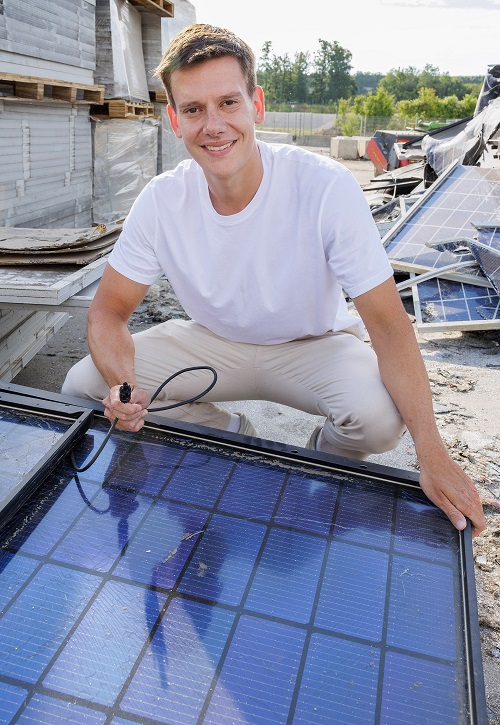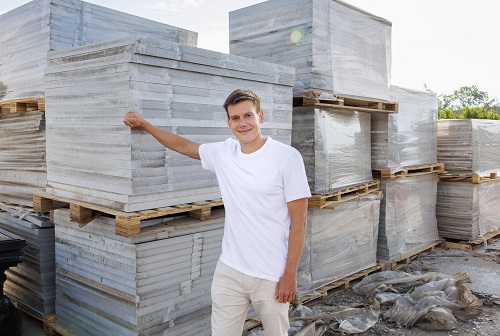PV modules make an important contribution to reducing CO₂ emissions. But what happens to the modules when they reach the end of their service life? With the expansion of solar energy, the number of end-of-life photovoltaic modules is also increasing, and with it the need for sustainable recycling solutions. A task that the Müller-Guttenbrunn Group is currently tackling. After all, the company wants to be an industry pioneer once again in this material flow of the future.

Maximilian Müller-Guttenbrunn sees PV recycling as a major future market: „The service life of PV modules is typically 20 to 25 years. However, many are replaced earlier because more powerful modules come onto the market and replacement often makes economic sense.“
The energy transition is in full swing, and with it comes a new challenge: the professional disposal and recycling of photovoltaic modules. „As the Müller-Guttenbrunn Group, we don’t want to miss out on this important material flow. That’s why we are working intensively on sustainable solutions to process old modules in a way that conserves resources. After all, PV modules are a recyclable material stream of the future,“ reports Maximilian Müller-Guttenbrunn.
PV modules in Austria: 6500% increase in 13 years!
The statistics show that the topic of recycling and reusing PV modules is becoming increasingly important: Installed PV output in Austria has risen sharply in recent years. In 2010, the total output of all PV systems in operation was 98,5 megawatts peak (MWp). In 2015, it was 937 MWp, five years later 2043 MWp and in 2023 even 6395 MWp. This corresponds to an increase of almost 6500 % in just 13 years! Even if the annual increase is currently declining slightly (2023: 2603 MWp, 2024: 2225 MW9 and 1300 to 1500 MWp are expected for 2025), the total PV area in Austria continues to increase.
Looking at the typical lifespan of PV modules – around 20 to 25 years – it is clear that a sharp increase in the number of installations is to be expected soon. However, this will not only be due to age. Many systems will be replaced prematurely as more powerful modules come onto the market and replacement becomes economically viable.
PV recycling? A matter of course for us!
For the Müller-Guttenbrunn Group, one thing is clear: recycling is not only a legal obligation, but also a central component of the circular economy. That is why the development team at MGG has already established a functioning solution for recycling PV modules – certified in accordance with CENELEC and available directly at the Amstetten site. According to Maximilian Müller-Guttenbrunn, however, there is still a lot to do: „Our current recycling approach has not yet reached the end of its development. We are currently working on separating the individual components of PV modules even better in order to be well positioned for significantly larger quantities in the future.“

The major challenge in recycling PV modules lies in the glass, which must be available in very high purity so that it can be reused on a large scale – ideally even for new PV modules.
The challenge: recovering glass of the highest purity.
When recycling PV modules, the focus is particularly on glass, which makes up the largest proportion of a module by mass at around 73%. If large quantities of old modules are produced in the future, this glass must be recovered in very high purity so that it can be reused – ideally even in PV module production. However, this is precisely the biggest challenge: the current sales channels for used glass from PV modules are still transitional solutions and are not designed for the large return flow of the coming years. This is because the glass must be completely separated from the coatings and adhesives in order to be reused as a high-quality recycling material.
Daniel Forstner in particular is working on this technologically and economically viable solution at MGG – both internally and in research projects such as ‘Apollo’ and ‘PVReValue’. The aim is to achieve an efficient, scalable separation of the individual components. To summarise the ‘state of the art’, it can be said that a lot still needs to be developed in the recycling process. MGG is currently examining whether these processes can be realised with the existing systems or whether an additional unit may need to be developed.
Legal framework conditions are a challenge for owners
Anyone who wants or needs to dispose of their old PV modules today can take the old modules to MGG Metrec in Amstetten Industriestrasse. Due to the complex composition – around 73% glass, 12% plastic, 10% aluminium, 3% silicon and 2% other metals – a moderate disposal fee is charged. In return, however, MGG guarantees sustainable and professional processing.
A further hurdle in disposal lies in the legal status of used PV modules. These are considered commercial devices and therefore do not have to be taken over by municipal waste collection centres. This means that the responsibility usually lies with the owners and many do not know what to do with their old modules. In principle, the extended producer responsibility applies in this case, according to which the manufacturer or distributor is responsible for collection and recycling. However, after 20 years on the roof, it is often no longer possible to trace who this was. This is exactly where MGG comes in and offers reliable, certified collection for large and small quantities.

„Photovoltaic modules consist of 73% glass, 12% plastic (cabling, etc.), 10% aluminium (frames), 3% silicon and 2% other metals,“ reports Maximilian Müller-Guttenbrunn.
Reuse instead of recycling: A second life for PV modules!
„In addition to traditional recycling, we at MGG are also thinking one step ahead – and are focussing on reuse: together with the start-up 2ndcycle, in which we are involved, we are pursuing an innovative approach to extending the service life of PV modules,“ explains Maximilian Müller-Guttenbrunn.
This is because many decommissioned modules are still technically functional. In a test line developed by 2ndcycle, these modules are analysed fully automatically and – if they are suitable – given a second life cycle. The industrial test is carried out at laboratory level and comprises several steps: cleaning and partly AI-supported visual inspection, flash test (STC performance test), electroluminescence, insulation test and wet leakage test, UV fluorescence, spectrometry, type plate recognition using OCR and LLM, dark characteristic measurement, bypass diode test, module measurement, UID assignment as well as database entry and classification. At the end, there is a test report for each individual PV module. If all criteria are met, the module can be placed back on the market as a ‘new’ product.
In this way, a module that was originally labelled as waste can be legally resold and reused, in the interests of conserving resources. However, the question of profitability is still open with this reuse approach, as Maximilian Müller-Guttenbrunn explains: „We are still investigating how big the market for tested used modules really is, but the potential is there!“
The MGG conclusion: We are thinking ahead!
Whether recycling or reuse – Maximilian Müller-Guttenbrunn is convinced that the volume flow of photovoltaic modules will come: „We want to be prepared for this. With existing recycling processes, ongoing technology development, research collaborations and a forward-looking reuse approach, we at the Müller-Guttenbrunn Group are focusing on a holistic solution for one of the most important material flows of the coming decades!“
Would you like to hand in modules or find out more about the recycling solutions? Visit MGG Metrec at Industriestraße 12 in Amstetten or take a look at www.mgg-recycling.com.

Anyone wishing to dispose of old PV modules – whether in large or small quantities – can take them to MGG Metrec at Industriestraße 12 in Amstetten. The Müller-Guttenbrunn Group guarantees sustainable and professional processing.
